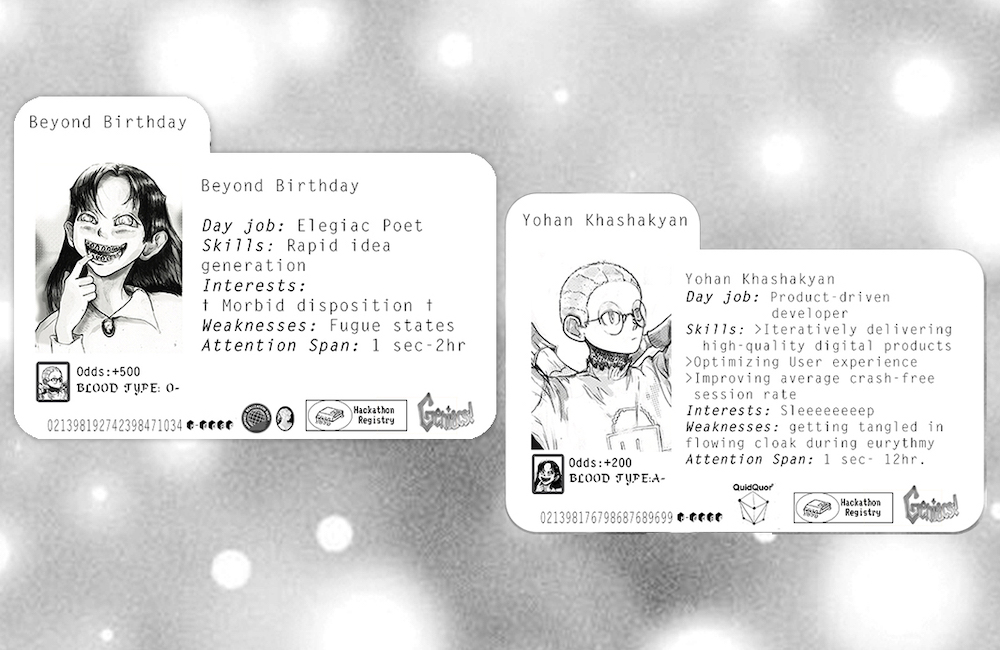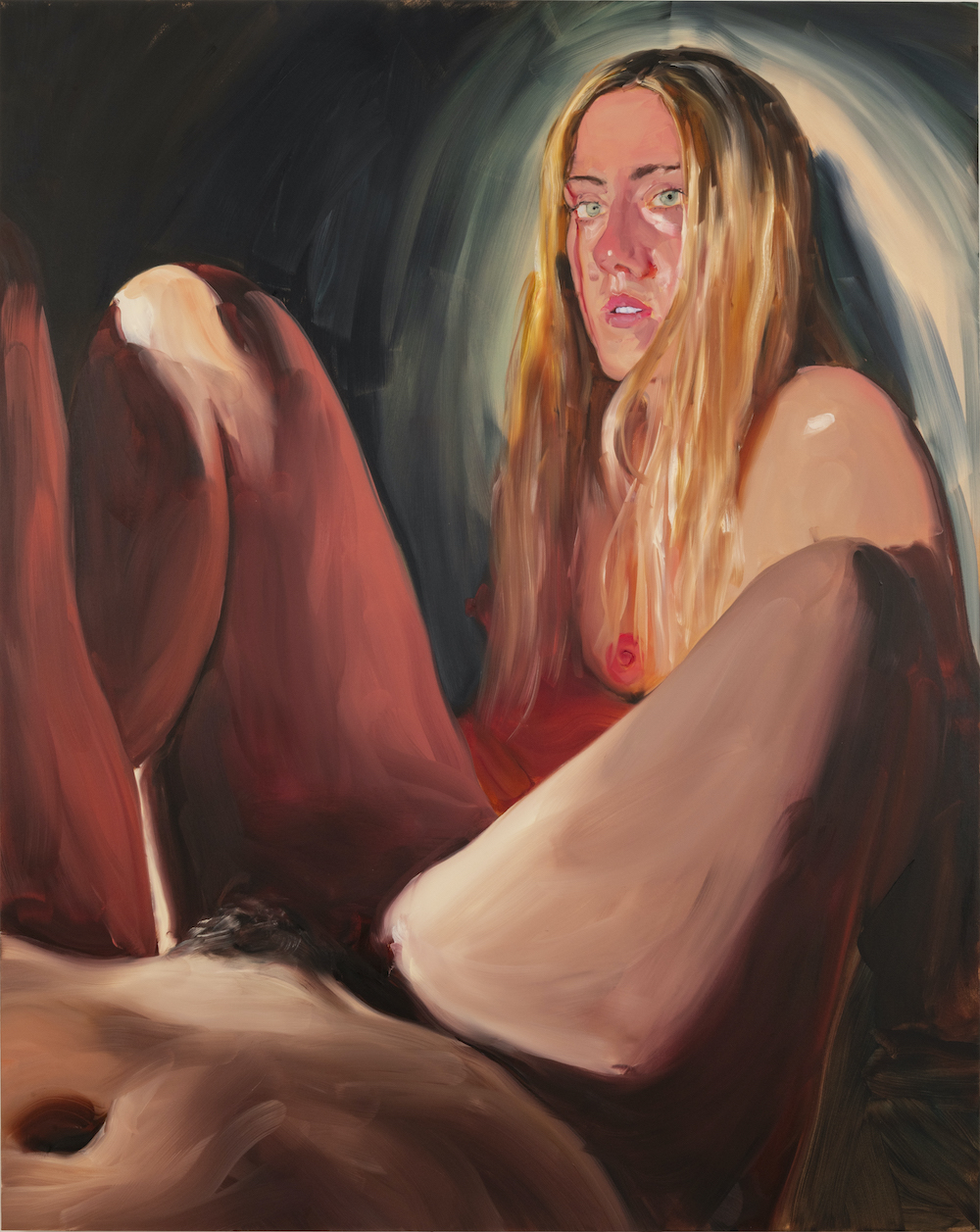Liby Hays’s Geniacs!, a graphic novel out this summer from the art book publisher Landfill Editions, takes place at a hackathon—truly inspired material for slapstick comedy, body horror, and philosophical reflection alike. This tech competition’s goal? Invent a new life-form. “People always think my ideas are dumb … but they’re purposefully so! Their failure is coded within them! It’s like when scientists artificially reanimate the cells of a dead pig’s brain. The brain becomes trapped in an infinite loop reliving the terror of its final moments. But within that narrow terror loop… We might find potential for new forms of thought to arise!” So muses our heroine, a morbidly minded wordsmith undercover as a “po-ent” (poet-entrepreneur). Her (hot, tattooed) slacker partner would rather copy and paste some old code, though, than entertain her inefficiently emo-poetic concepts. Hays’s detailed black-and-white illustrations are as gymnastic, compositionally, as her characters’ dialogue: her panels cut across the page in dizzying fits of polygons and word bubbles that leave us spiral-eyed, minds buzzing, cartoon birds circling our heads. A canny and cryptic meditation on group projects, life, “life,” art, and the cheat code lifestyle only slightly more surreal, though much more fun, than my worst nights of coding. —Olivia Kan-Sperling
“In a city we are forever brushing sleeves with our other possible selves,” writes Lauren Elkin in her latest book, No. 91/92: A Diary of a Year on the Bus, culled from a series of iPhone notes compiled during her 2014 commute in Paris. “Underground we go shooting through the tunnels trying to survive and be happy.” Drawing on the works of Georges Perec and the subway poems of Jacques Jouet, Elkin situates her observations within an Oulipian history of randomness and chance, suggesting that a life mediated through a screen is just as susceptible to the what-ifs, daydreams, and abrupt interruptions of a life lived away from one. —Rhian Sasseen
“I’m talkin’ neat, like freak. / I’m talkin’ neat, like fleek. / I’m talkin’ neat, like a geek.” —Brian Ransom
I encountered Jenna Gribbon’s Watching Me Swim (2018) on a corner of the internet called gay Tumblr, which is practically a tautology. It was a coup de coeur for me, seeing her work for the first time. Running through October 30 at Fredericks & Freiser, her solo show “Uscapes” comprises newer works. It’s no surprise that Gribbon’s girlfriend Mackenzie Scott (not that one), who performs music under the name Torres, appears as muse in every piece. This has become a hallmark of Gribbon’s work, as have lovely, messy domestic scenes—Scott clipping her toenails on the lip of the bathtub, for one—and cleverly composed, reflexive nudes. It’s easy to fixate on the details—the omnipresent neon-pink areolae, the intricately rendered folds of fabric, the glint of Scott’s fingernails as she props her hands in front of her vulva in one portrait, the fleshiness of a belly in another. These minutiae clash nicely with the works’ louder elements. Fat swipes of paint bear the memory of a brush’s grooves, and about half a dozen pieces on view are massive, like the nearly seven-foot-tall Interrogation Lightscape (2021), in which Scott appears as a kind of giantess, haloed by white light, sitting naked between a pair of thighs, holding eye contact. As we orbited the gallery, my buddy spun around and let out a laugh. “She’s always teasing us, you know. She’s making fun of the viewer,” they said, gesturing toward a painting of Scott pissing into the dirt. Toying with the voyeur—and with the tropes of figurative painting—is surely an energizing force here. Gibbon’s paintings emerge, in her own words, “from inside the scopophilic feedback loop.” —Jay Graham
Getting me through this week is The Magic of Now, a new live album by the pianist and bandleader Orrin Evans, which was recorded this past December at the Smoke Jazz & Supper Club, in New York City. The band photo in the CD shows the rhythm players—Evans, the bassist Vicente Archer, and the drummer Bill Stewart—all masked, their hands flying over their instruments; only the rising star sax player Immanuel Wilkins isn’t masked, for obvious reasons, but he’s surrounded by see-through barriers. It’s a moving document of the perseverance of art through the pandemic, and the music makes a powerful case for art’s necessity. This is just really great straight-ahead jazz, nothing tricky, just lots of power and passion and the chance to hear Wilkins, who seems to be everywhere in jazz right now, play the hell out of his horn as though all our lives depended on it. —Craig Morgan Teicher
One undeniable certainty about studying religion in any academic way is that, without even trying, you find yourself having opinions on famous heretics—more precisely, you have favorites. My personal favorite heretic is Menocchio, the subject of Carlo Ginzburg’s 1976 study of sixteenth-century popular culture The Cheese and the Worms. Ginzburg’s project breaks the mold of social history by building a narrative from the bottom up, using source materials as far removed from structures of power and influence as he could dredge up, trying even to get at the texture of oral culture lost to time. The protagonist that emerges is an incredibly learned, charismatic, and irreverent miller who, in the face of the Roman Inquisition, imagined a view of creation that rings through centuries by way of Ginzburg: “All was chaos, that is earth, air, water, and fire were mixed together; and of that bulk a mass formed—just as cheese is made out of milk—and worms appeared in it, and these were the angels.” —Lauren Kane
from The Paris Review https://ift.tt/2XnaYae



Comments
Post a Comment